
Want to learn more? This National Geographic Book on Owls is a great read!
The Great Horned Owl is the most common in North Carolina.
The state of North Carolina is classified as having a subtropical climate with often very humid weather. North Carolina has 41 different state parks and 10 different National Parks.
In North Carolina, there is an area called The Coves that spans over 36 acres of land and included several birding trails, perfect for spotting owls.
Now that we’ve discussed where best to see these owls, let’s take a look at these thirteen unique species in detail and look at when and where you may be able to see them.
Want to attract Owls to your yard? Take a look at our article!
What Owls can be seen in North Carolina?
Table of Contents
1. Barn Owl
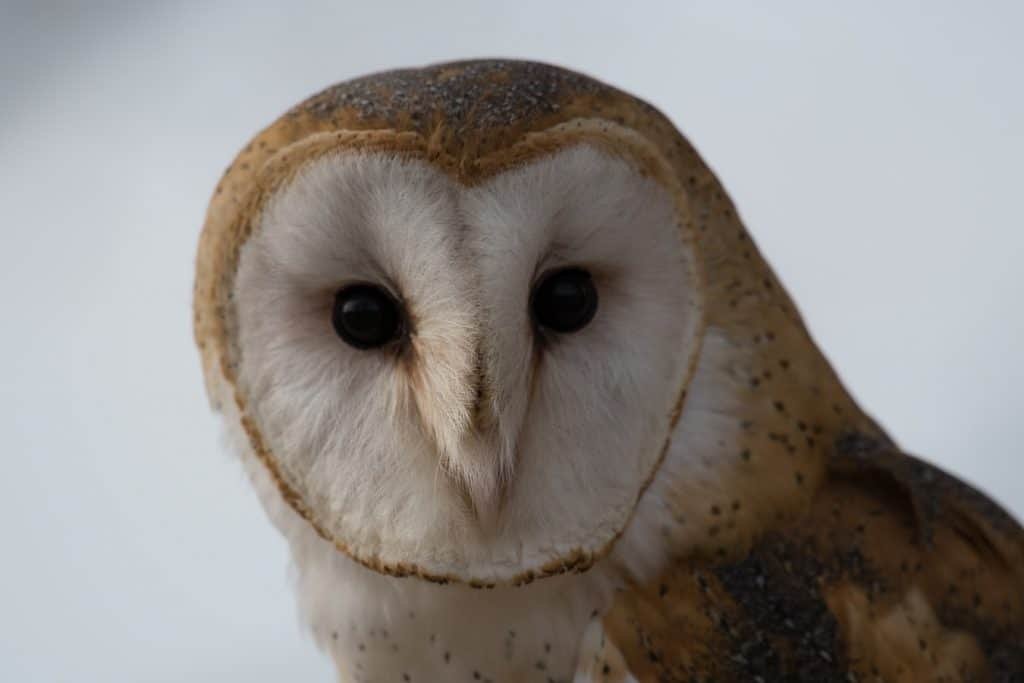
Wingspan
107 to 110 cm
Weight
430 – 620 g
Life Expectancy
Up to 4 years
Diet
Voles, Shrews & Mice
Barn owl’s heads and wings are covered with buff and grey feathers, they have a medium sized body that is rather stocky.
During the night-time these feathers on their wings can appear to be completely white.
These birds have a wide range going from southern Canada to across 48 states in the USA.
Barn Owls form breeding pairs that mate for life and remain monogamous during the breeding season.
During the mating season, a male will bring the female food whilst she incubates the eggs.
Males will also spend most of their time surveying their territory so that they can defend it.
These birds are very territorial to other bird species, but they have been known to happily share hunting grounds with different Barn Owls.
You are most likely to see one of these birds hunting over open grasslands during the night.
Due to their high abundance, Barn Owls are one of the more common species of owl to be seen across North Carolina.
They are permanent residents of the state and can therefore be seen year-round.
Their nesting sites have been recorded across the whole of the state with the highest number of sightings being in the western regions.
2. Flammulated Owl
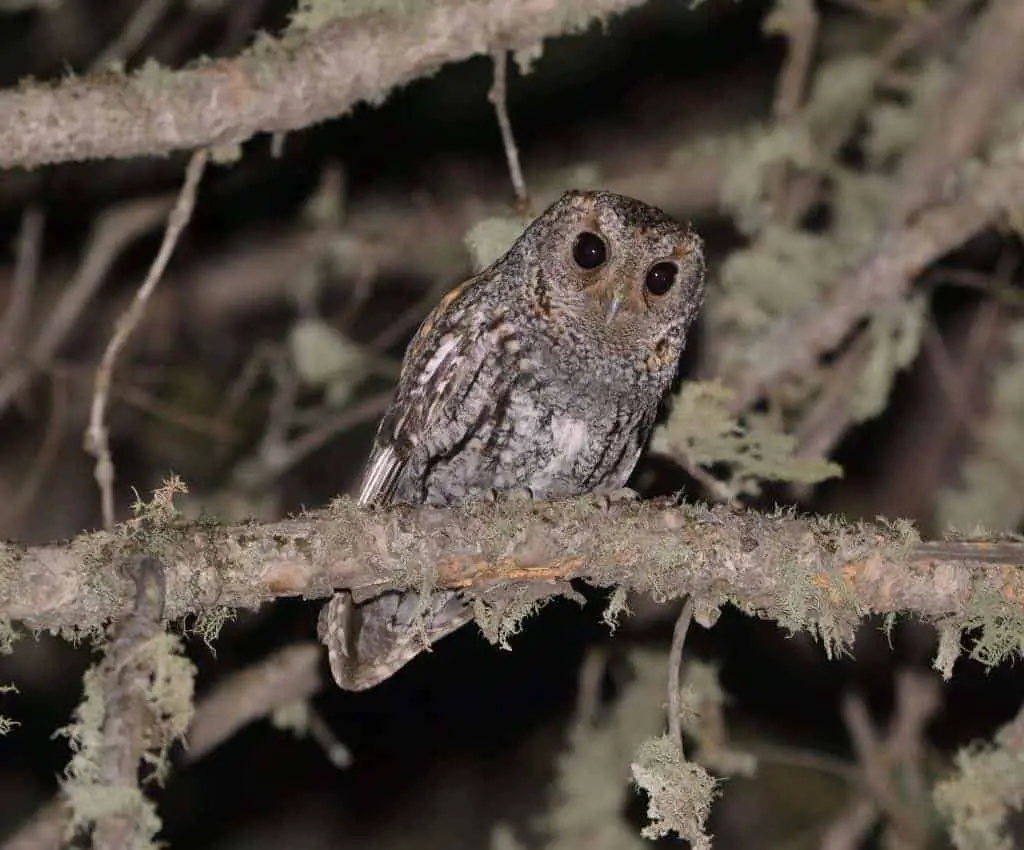
Wingspan
14inches
Weight
60g
Life Expectancy
8 years
Diet
Mostly insects
The Flammulated Owl is a very small species of owl that is known for being able to easily camouflage themselves against dense trees.
They are able to camouflage well due to their rusty and grey coloured feathers.
About 75% of Flammulated owls form long term breeding pairs and all of these owls are monogamous during the breeding season.
Flammulated Owls have large territories of about 5-6 acres and are very defensive of them.
They will chase other owls away from their territories, but it is very rare that a fight will occur between two individuals.
They appear to stay mostly in the forests of Mexico during the winter months, though their range in winter has not yet been well studied.
You are most likely to find these birds in forest habitats, usually more dense and coniferous habitats as that is their preferred area to nest.
The Flammulated Owl’s range does not currently encompass North Carolina, so you are very unlikely to see a nest of theirs in the state.
However, these birds are migratory and there has been a few sightings outside of their breeding season to the west of North Carolina.
3. Eastern Screech Owl
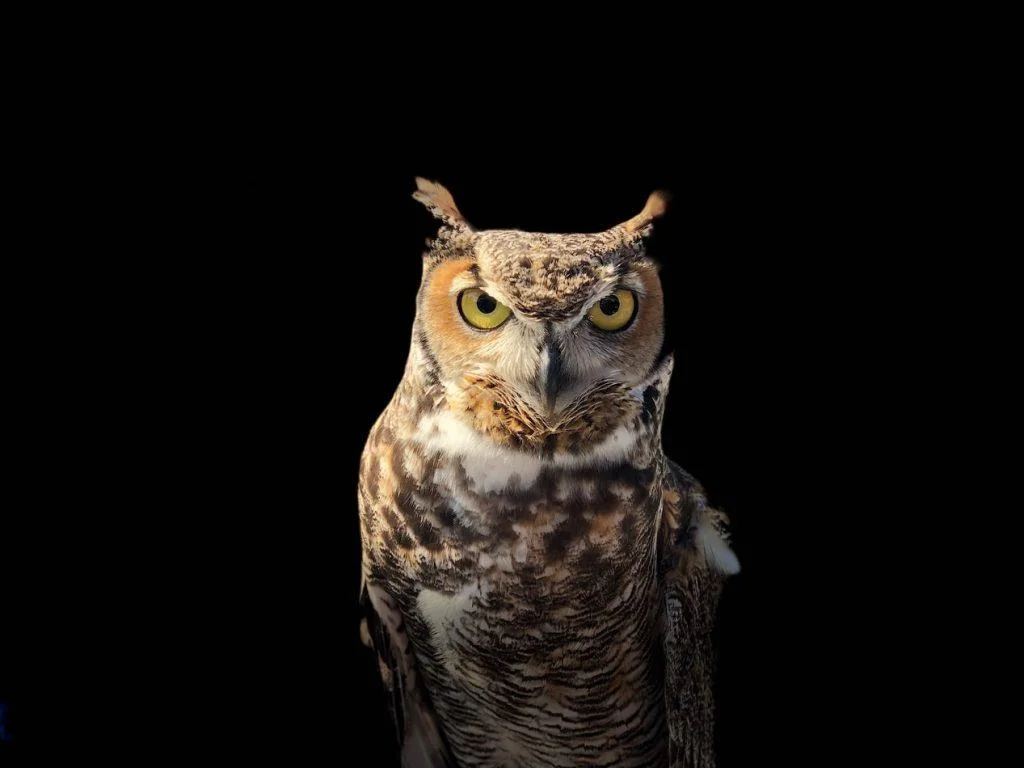
Wingspan
46 to 61 cm
Weight
160 g
Life Expectancy
14 years
Diet
Rats, Squirrels, Rabbits & Skunks
The Eastern Screech-Owl looks very similar to the Western Screech-Owl, both have stocky bodies covered in thick grey feathers.
These owls are not monogamous during the breeding season, but males appear to stay with a single female through the months so that he can defend his nest.
These pairings are also not a long-term thing and will change every year.
Females will incubate the eggs and stay in the nest for most of the season, whilst males spend most of their time defending their territory.
In recent years, these owls have increased their nesting range to suburban areas and have successfully bred in city parks.
They are also happy to use manmade bird boxes, although they prefer to stay in dense forest areas.
These owls are one of the more abundant species to be found in North Carolina.
As their name suggests, their range is to the east of the United States, meaning that they are permanent, year-round residents in the state.
They can be seen all across North Carolina with the most sightings being recorded in the south east.
4. Western Screech Owl
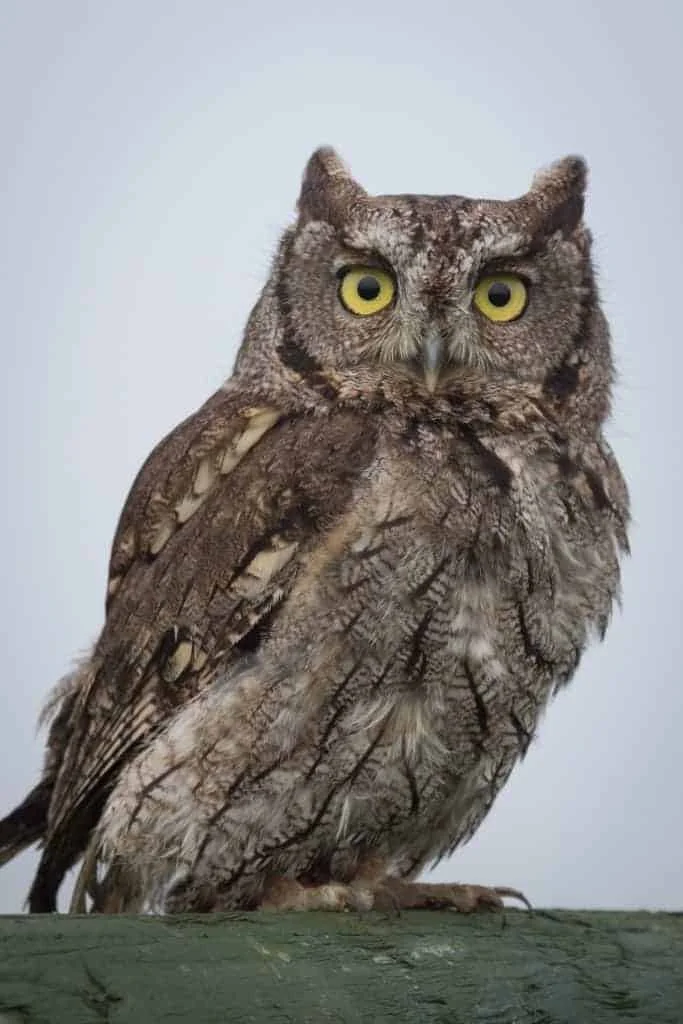
Wingspan
55cm
Weight
143g
Life Expectancy
13 years old
Diet
Insects and small mammals
The Western-Screech Owl is covered in grey feathers and they have a very stocky body.
These birds like to make their nests along the edges of canyons and in wooded areas where possible.
In recent years they have also been observed moving into suburban and urban areas.
These owls are not monogamous during the breeding season, but a male will stay with one female that he has mated with to help her raise the brood and defend the nest.
Their nests are made inside of tree cavities and whilst the female stays in this cavity to incubate the eggs, the male will bring food to her.
Breeding pairs will defend their nests together from different birds, a common bird that tries to disturb their nests is the crow.
They have also been observed roosting together and singing duets during the breeding season.
As suggested by the name, the Western Screech-Owl’s range is to the west of the United States, so they are not common owls in North Carolina.
There have been sightings of this bird in the state though, these sightings have all been outside of the breeding season and have occurred in the south west of the state.
5. Great Horned Owl

Wingspan
~140cm
Weight
1.4 kg
Life Expectancy
28 years old
Diet
Squirrels, Rabbits & Skunks
These owls do not actually have horns but instead have large pointed ears that look like horns. Their large bodies are covered in thick feathers that are greyish brown in colour.
Great Horned Owls will form breeding pairs that will stay close to each other outside of the breeding season.
Most of these breeding pairs are long term as these owls appear to mate for life.
They remain monogamous during mating seasons. Both members of the breeding pair will defend their territory with a series of sharp hoots and females are as defensive as the males.
Fights will often break out between these owls and breeding pairs have been known to kill members of their species that stray too close to their nests.
Great Horned Owls are also often harassed by smaller bird species that try to get them to abandon their nest and their eggs.
As the most common owl in North Carolina, the Great Horned Owl is a year-round resident of the state.
They can be seen across all of North Carolina and are most active during their breeding seasons. Most of the sightings have been recorded to the west of the state.
6. Northern Saw-whet Owl
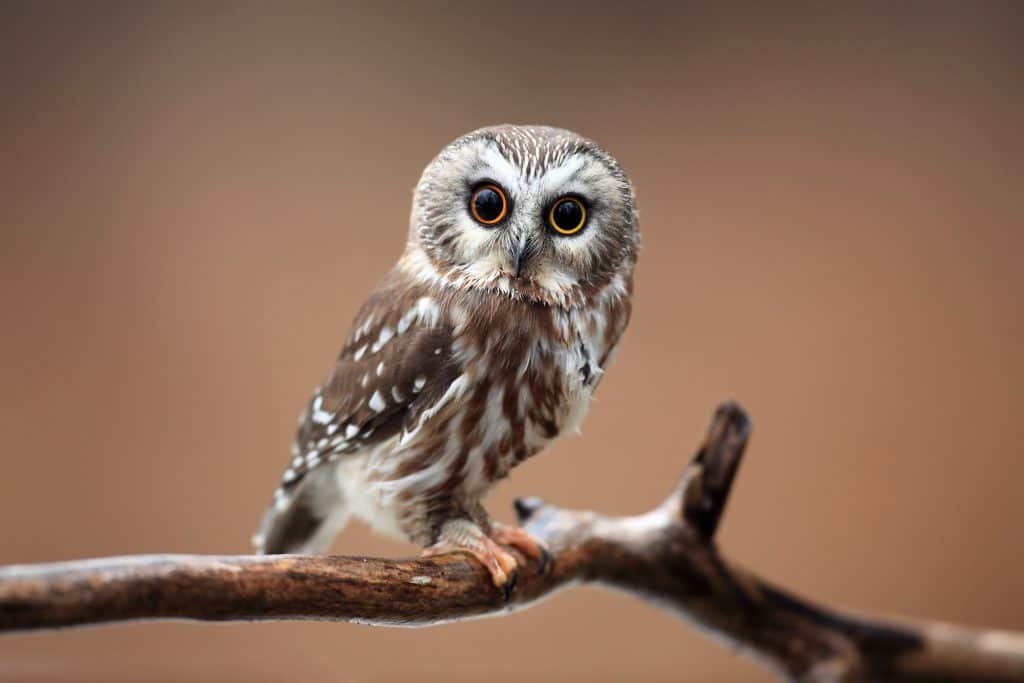
Wingspan
40 - 60 cm
Weight
100 g
Life Expectancy
7 years
Diet
Small birds, young squirrels, voles & shrews
The Northern Saw-whet Owl is small in size for an owl and its body is covered in deep brown feathers.
These small owls will roost throughout the day and make their nests in dense wooded areas.
These birds are primarily monogamous and will form breeding pairs, however, some males have been recorded to mate with several individuals each year.
These will often stay together outside of the breeding season to help each other defend their territory, but a lot of these breeding pairs also change from year to year.
You will hear their distinct too-too-too mating call throughout the breeding season, which is from the end of January to the beginning of May.
A male will circle around any female that enters his territory 20 times before moving down to her and gifting her with a prey item.
They prey item is most commonly a rodent such as a lemming or a mouse.
These birds need to be careful when hunting, particularly at night, as they are often preyed upon by larger species of owls.
The North Saw-Whet Owl has a large range which encompasses the whole of North Carolina.
However, when you are most likely to see them depends upon the region of the state.
They are not seen in the state at all during their breeding season, but outside of this season they are quite abundant in the north of the state.
They are also seen in the south of the state outside their breeding season, but this tends to be in the winter months when they move further to find more food sources.
7. Short-Eared Owl
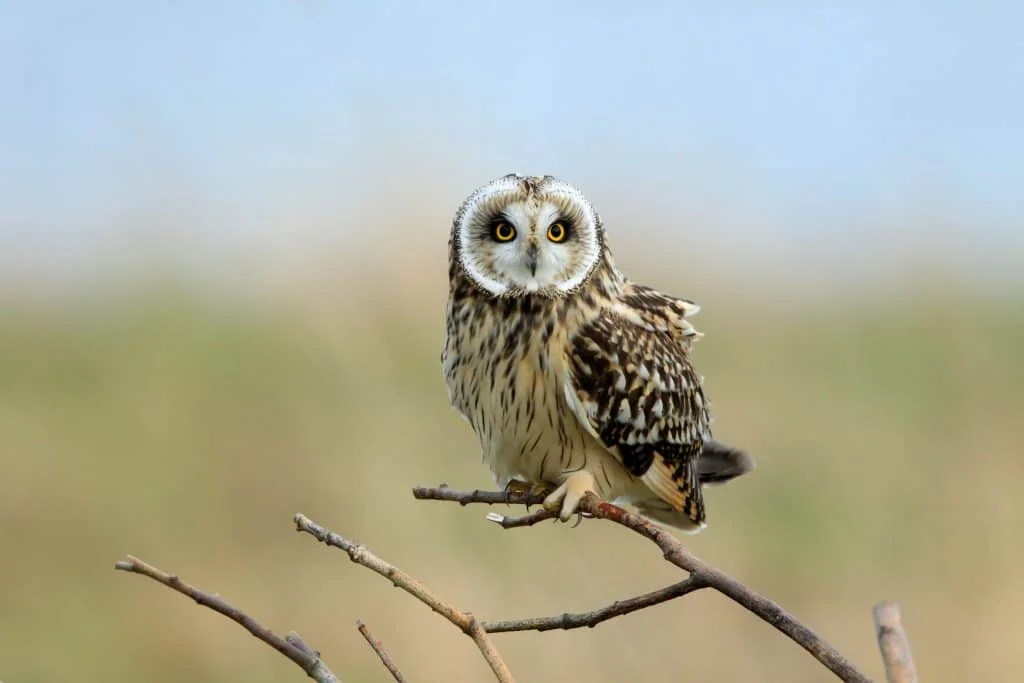
Wingspan
85 to 110 cm
Weight
206–475 g
Life Expectancy
4-12 years
Diet
Voles, Mice, Squirrels
Short-eared owls, in contrast to the Long-eared Owl, do not have any visible tufts which is where they got their name from.
They have brown feathers that cover their stocky bodies and sometimes have patches of white across their bellies or wings.
These owls will hunt throughout open grassland areas and have adapted to be able to hunt in both the day and the night.
The open areas make it easier for them to spot and swoop down to their prey. Short-eared owls form breeding pairs, but not a lot is known about these breeding pairs, although they don’t appear to mate for life.
They remain monogamous during the breeding season and males will help females with raising the brood.
These owls make their nests in areas of tall grass rather than trees and will only roost at higher elevations during the colder months.
Females remain at the nest, incubating the eggs and males will defend their territory with a series of harsh calls. They also bring food to the females.
Short-Eared Owls will often form loose colonies of lots of individuals that stay near each other during the breeding season as well as the rest of the year.
These birds are not permanent residents of North Carolina, but they are still quite common. They are only in the state outside of their breeding seasons, which is primarily late summer to winter.
These birds have been recorded across all regions of the state, the most abundant number of sightings is along the eastern coast of the state.
8. Snowy Owl
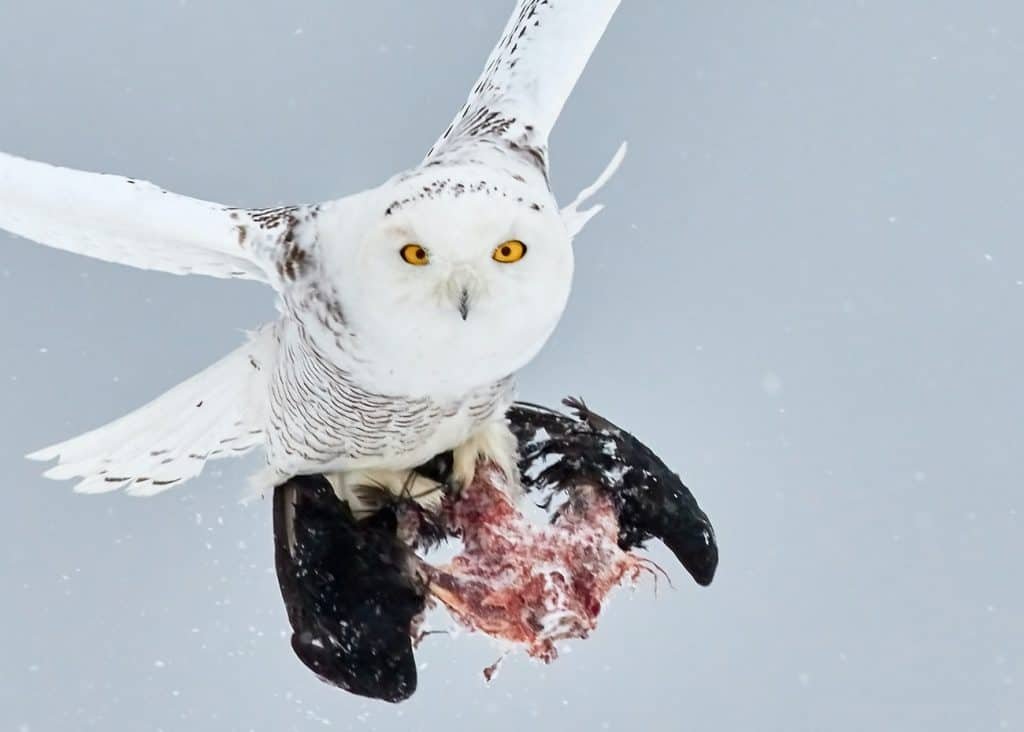
Wingspan
150 cm
Weight
2 kg
Life Expectancy
10 years
Diet
Birds, Rabbits, Fish & Rodents
These owls are on the larger side of the owl species and are covered in thick, crisp white feathers that sometimes have individual speckling of black and grey on their tips.
Snowy Owls make their territories in open plain and tundra areas and are incredibly defensive of their territory.
They will often fight other snowy owls and different owl species, there has been one reported occurrence of a pair attacking an arctic wolf.
These owls will spend a lot of their time perched on high places such as telephone poles to observe their territory and look for prey.
Males will court females using and aerial display which involves diving rapidly towards the ground with their wings in a v shape.
They will gift the female with a small prey item that they have grasped in their talons during this courtship display.
Apart from this, not a lot is confirmed about their breeding behaviours and it is uncertain as to whether they are monogamous or not.
The Snowy Owl has been only rarely seen in North Carolina; it will only come into the state when it moves further south across America to deal with the cold winter months.
The recorded sightings of these owls have all been to the north of the state.
9. Long Eared Owl
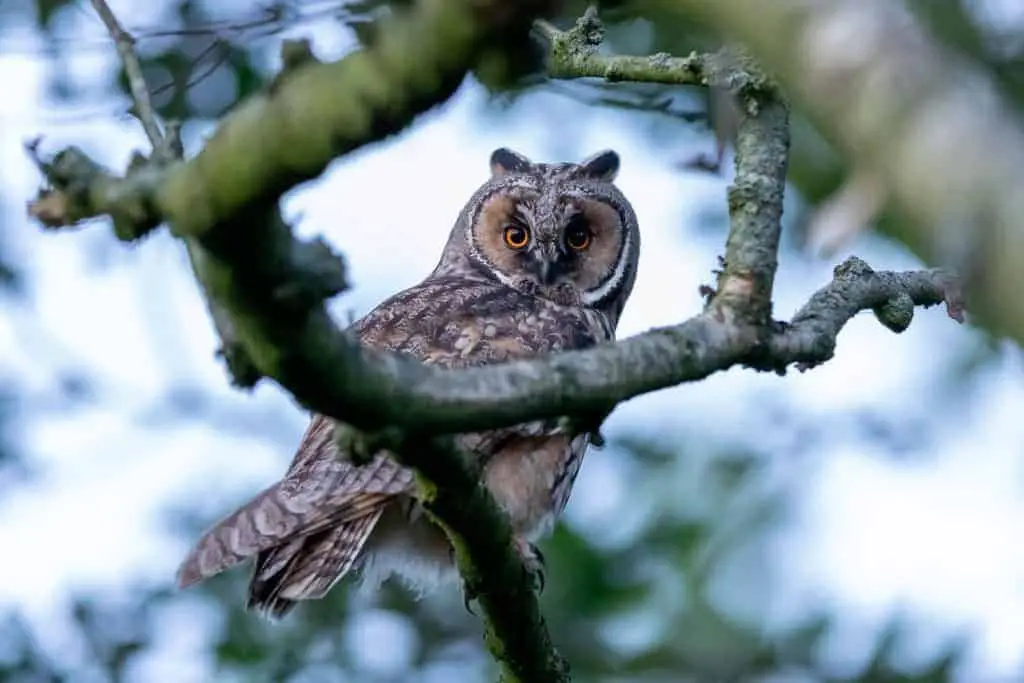
Wingspan
90 to 100cm
Weight
250 g
Life Expectancy
4 years
Diet
Small mammals, mice, rats & rabbits
The Long-Eared Owl unsurprisingly gets its name from its large, long and prominent ear tufts.
They have orange faces and their bodies are covered with grey and brown feathers. These owls will form loose colonies of about 100 individuals, and they like to make their nests in dense woodlands.
During the breeding season these colonies will not roost together, but they will still nest near each other within their territories.
These birds are monogamous during the breeding season and form pairing to help raise the brood.
It is unknown as to whether these breeding pairs stay together in the long term or if they change every year.
Males perform a series of complex, zigzag flights whilst producing a mating call when they are trying to court a female.
Whilst these birds have been reported across the whole state of North Carolina, they are not very common there.
They will only come into North Carolina outside of their breeding season and whilst they have been seen across the whole state, they only have two abundant regions.
These regions are in the far north west and far south east of the state.
10. Boreal Owl
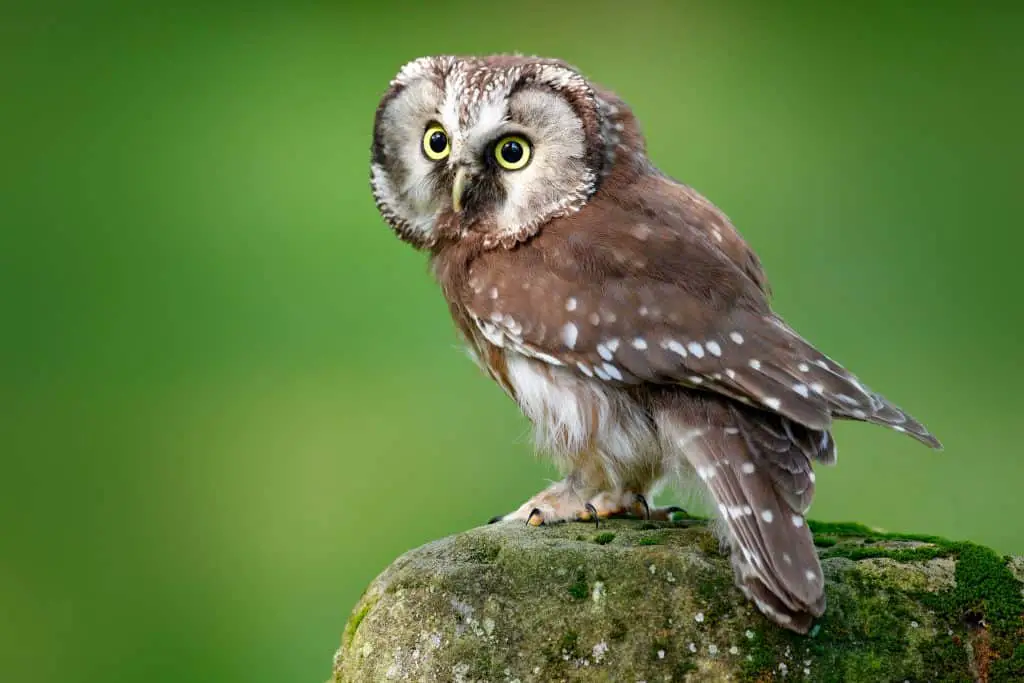
Wingspan
50–62 cm
Weight
120 g
Life Expectancy
16 years
Diet
Small mammals, birds & insects
The Boreal Owl does not have any ear tufts and has a unique square shaped head. Its body is short and stocky, much like its tail feathers.
These birds are a rich brown colour with spots of white on their back and streaks of white feathers across their belly.
Boreal owls form breeding pairs, but they are very solitary birds and they do not roost together.
They have minimal interactions that include courting, mating and feeding but they will not spend any time together outside of the breeding season.
These birds will mate with different individuals each year, but they remain monogamous during the mating season.
Males will act to defend their territory with a series of calls and songs, but they do not defend large areas and instead only defend close to their nesting cavity.
You are most likely to see a Boreal Owl in a variety of woodlands and in America will often stay in woodland areas that are close to mountain ranges.
These birds are not very common in North Carolina as their range does not extend that far south.
That being said, these birds are largely nomadic and will move across the states when prey is scarce in search of new food sources.
This usually occurs in winter and sightings in North Carolina have been to the north east of the state.
11. Northern Pygmy Owl
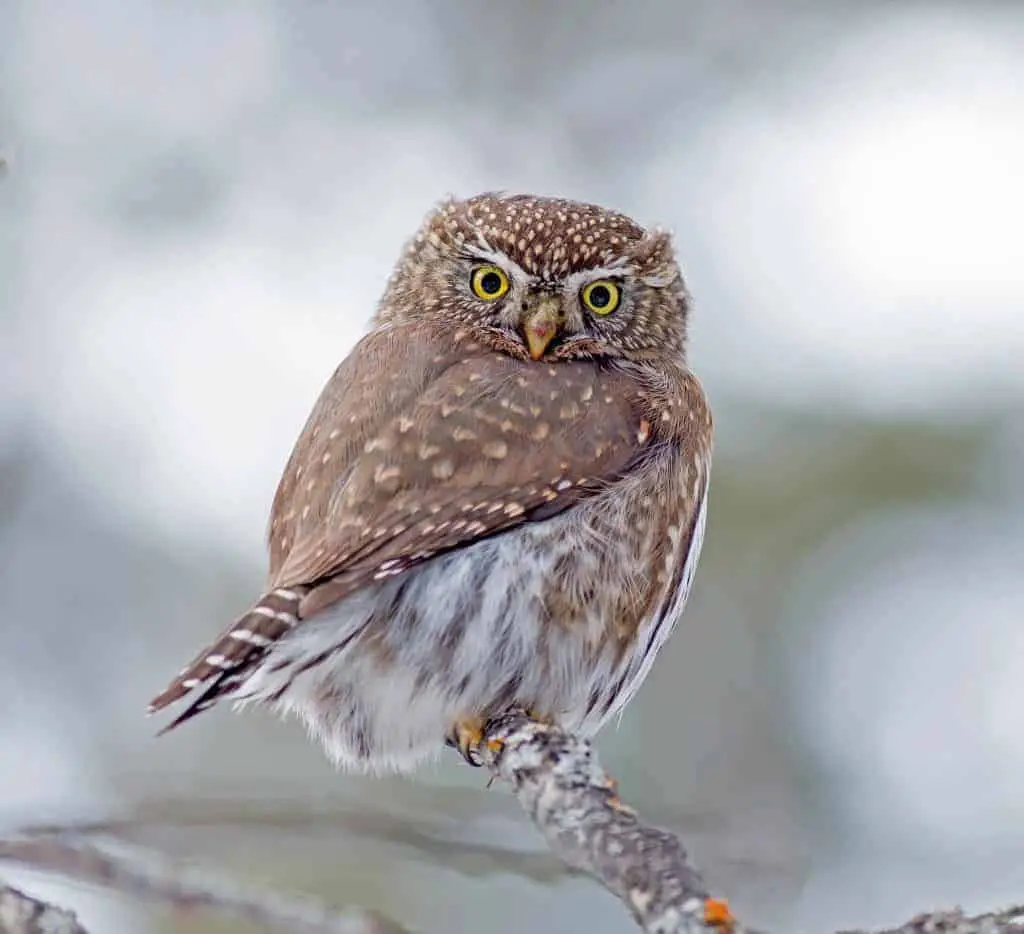
Wingspan
15 inch
Weight
2.25oz
Life Expectancy
6-7 years
Diet
Small birds
The Northern Pygmy-Owl is known for its spherical head and body and is utterly adorable.
They are one of the smallest species of owl known to man, which is why they are classified as a pygmy species.
In the winter months these owls have been known to stay closer to suburban towns, but for the rest of the year you will find them in dense wooded areas.
These birds hunt during the day to avoid confrontations with most night hunting owls as they are frequently preyed upon by larger owl species.
Males have a unique tooting call that they will use to attract females during the breeding season.
These birds are monogamous, and males will help the females raise the brood, though it isn’t known whether they form the same breeding pairs every year or if they change.
This bird is not a common visitor to the state of North Carolina. The only recorded sightings have been to the far west of the state as this owl’s range is mostly to the west of the USA.
These sightings have been recorded in winter, possibly because this is when they expand their search to reach more food sources.
12. Burrowing Owl
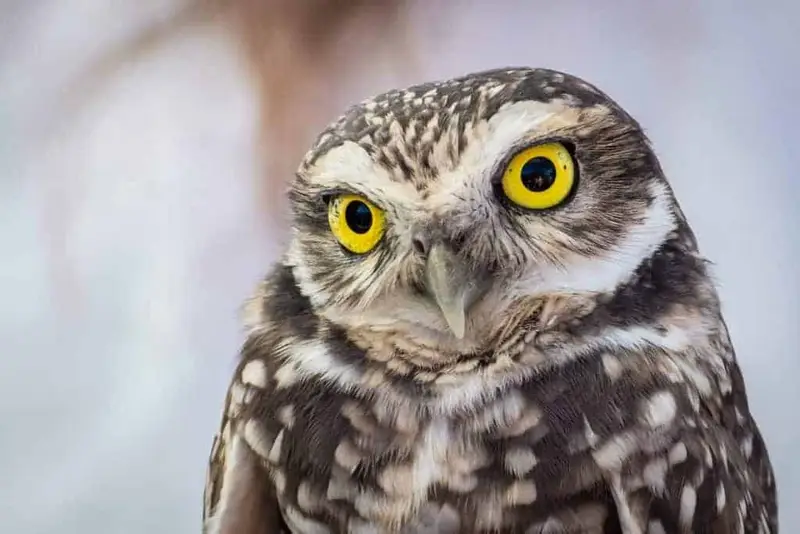
Wingspan
51-61 cm
Weight
140-240 g
Life Expectancy
10 years
Diet
Large Insects and Small Rodents
This small species of owl has brown and white feathers, with the white feathers sometimes forming a large patch of white on their bellies.
Burrowing Owls form loose colonies with a large number of individuals, and they stay together during the breeding seasons.
Whilst it is not known whether they form long term breeding pairs, it is known that they remain monogamous during the mating season.
After courtship, females stay in the burrow to protect the eggs whilst males defend the territory using their unique calls and wing displays.
These birds hunt over open areas of grasslands and have been observed hunting during the day and the night.
These birds have been spotted quite a lot in the state of North Carolina, though they are not permanent residents.
They are only seen outside of the breeding season and they are most commonly recorded as being in the west and south west regions of the state.
13. Spotted Owl
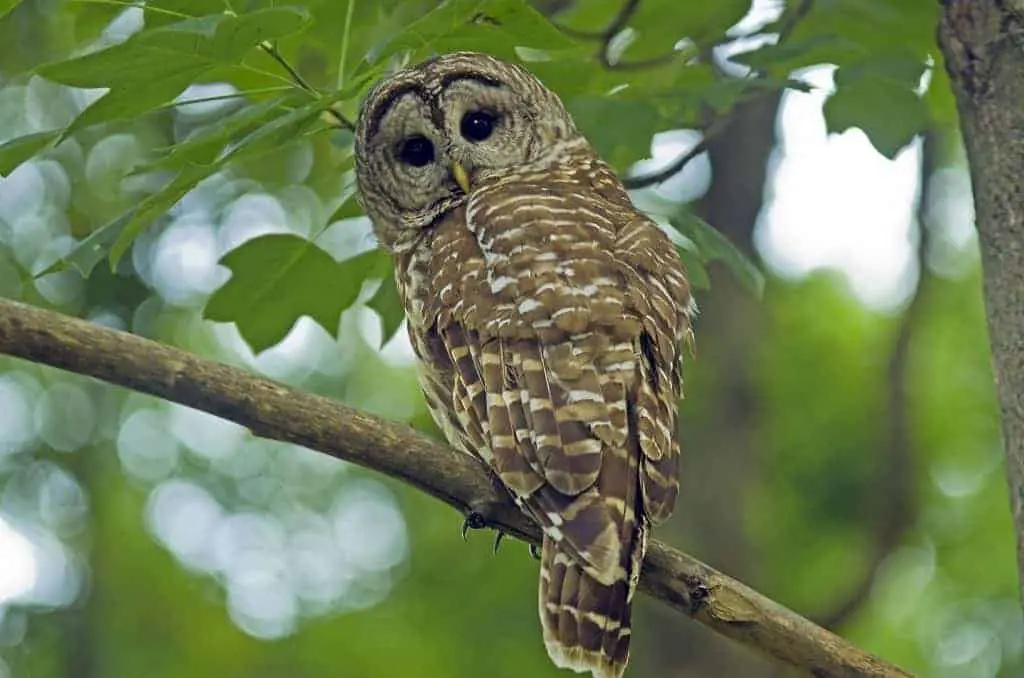
Wingspan
114cm
Weight
600g
Life Expectancy
16-21 years
Diet
Small mammals
The Spotted owl is covered in large numbers white spots that appear on its pale brown feathers; this is where it gets its name from. The owl has no visible ear tufts and is one of the larger species.
There are two sub-species of this owl, The Mexican Spotted Owl and the Northern Spotted Owl.
Both subspecies of Spotted Owls make their nests in dense canopies but will make their nests in more open woodlands if they have to.
Apart from during the breeding season, these birds are very solitary and breeding pairs do not interact with each other after they have raised the brood.
The breeding pairs are long term and they will both stay in their home ranges for the whole year, only interacting in the couple of weeks before mating occurs.
Spotted Owls move to different layers of the forest canopies to control their body temperature, so they do not need to fly long distances or migrate to deal with the changing seasons.
You will be very lucky to spot one of these birds in North Carolina and if you do, it will be the Mexican Spotted Owl.
Their range is largely to the west of the United States and throughout Mexico.
There have been some reported sightings of these birds to the south west of North Carolina, though there have not been any recorded breeding nests.

More Articles.
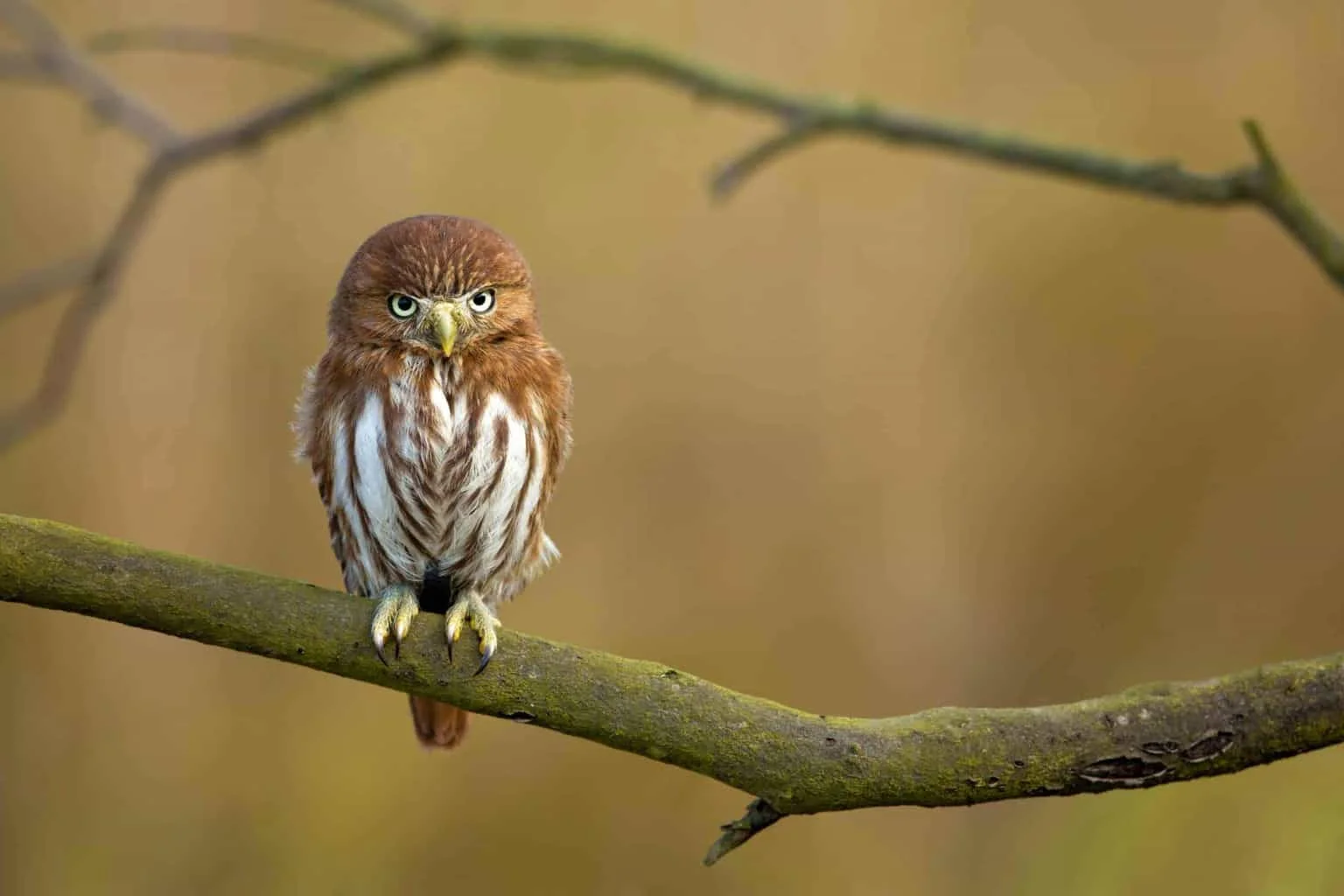
Owls are without a doubt one of the more interesting creatures around. These fearsome predators
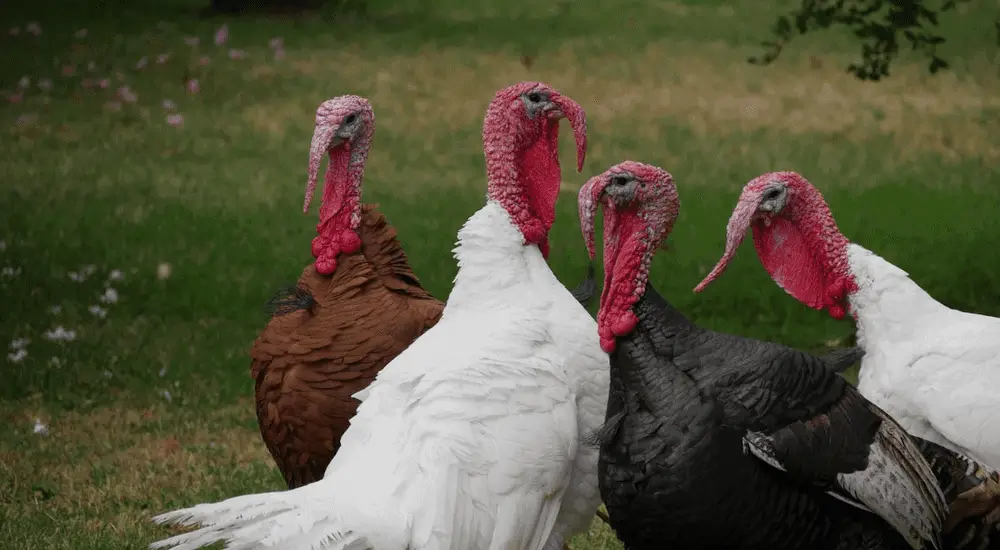
How to attract Wild Turkeys to your yard?
Wild turkeys can be provide quite a fascinating addition to your yard. Providing acorns in
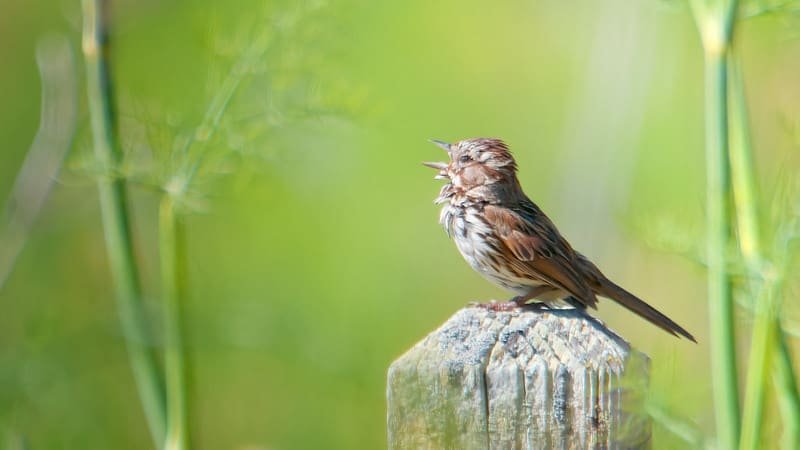
Why do Birds Chirp at Night? (5 Birds with Pictures and Sounds)
A bird singing and chirping can be heard at all times of the day. Most

About Us
We are avid bird-watchers who recently retired, allowing us more time to travel the world. Fortunately, we have managed to visit numerous countries around Europe, Asia, and America. Watching and photographing birds has been a passion for many years and we are making the most of the extra time on our hands!
